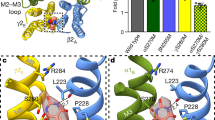Abstract
Purpose. A mechanism-based model is proposed for the analysis of adaptive changes in the pharmacodynamics of benzodiazepines in vivo.
Methods. The pharmacodynamics of midazolam was studied in the kindling model of experimental epilepsy. Concentration-EEC effect data from kindled rats and their controls were fitted to the operational model of agonism. A stepwise procedure was used, allowing changes in the parameters efficacy (τ) and tissue maximum (Em) either separately or in combination. The results were compared to data obtainedin vitro in a brain synaptoneurosomal preparation.
Results. The relationship between midazolam concentration and EEC effect was non-linear. In kindled rats the maximum EEC effect was reduced by 27± 8.3µV from the original value of 94± 4.4µV. Analysis on the basis of the operational model of agonism showed that this decrease could be explained by a difference in the parameter system maximum (Em) rather than efficacy (τ). In the in vitro receptor binding assay no changes in density, affinity or functionality of the benzodiazepine receptor were observed, consistent with the lack of a change in efficacy (τ).
Conclusions. The operational model of agonism provides a mechanistic basis to characterise adaptive changes in the pharmacodynamics of midazolam.
Similar content being viewed by others
REFERENCES
J. R. M. Haigh and M. Feely. Tolerance to the anticonvulsant effect of benzodiazepines. Trends Pharmacol. Sci. 9:361–366 (1988).
T. D. Hernandez, J. B. Rosen, and D. W. Gallager. Long-term changes in sensitivity to GABA in dorsal raphe neurons following amygdala kindling. Brain Res. 517:294–300 (1990).
A. Cleton, R. A. Voskuyl, and M. Danhof. Adaptive changes in the pharmacodynamics of midazolam in three different models of epilepsy: kindling, cortical stimulation and genetic absence epilepsy. Br. J. Pharmacol. 125:615–620 (1998).
T. P. Kenakin. Drug-receptor theory. In: Pharmacological analysis of drug-receptor interaction. Raven Press, New York, 1993, pp. 1–38.
P. H. Van der Graaf and M. Danhof. Analysis of drug-receptor interactions in vivo: a new approach in pharmacokinetic-pharmacodynamic modelling. Int. J. Clin. Pharmacol. Ther. 35:442–446 (1997).
J. W. Black and P. Leff. Operational models of pharmacological agonism. Proc. R. Soc. Lond. B. 220:141–162 (1983).
J. W. Mandema and M. Danhof. Pharmacokinetic-pharmacodynamic modelling of the CNS effects of heptabarbital using aperiodic EEG analysis. J. Pharmacokin. Biopharm. 18:459–481 (1990).
R. Racine, V. Okujava, and S. Chipashvili. Modification of seizure activity by electrical stimulation. III. Mechanisms. Electroencephalogr. Clin. Neurophysiol. 32:295–299 (1972).
J. W. Mandema, E. Tukker, and M. Danhof. Pharmacokinetic-pharmacodynamic modelling of the EEG effects of midazolam in individual rats: influence of rate and route of administration. Br. J. Pharmacol. 102:663–668 (1991).
R. D. Schwartz, P. D. Suzdak, and S. M. Paul. γ-Aminobutyric acid (GABA)-and barbiturate-mediated 36Cl− uptake in rat brain synaptoneurosomes: evidence for rapid desensitization of the GABA receptor-coupled chloride ion channel. Mol. Pharmacol. 30:419–426 (1986).
J. W. Black, P. Y. Leff, N. P. Shankley, and J. Wood. An operational model of pharmacological agonism: the effect of E/[A] curve shape on agonist dissociation constant estimation. Br. J. Pharmacol. 84:561–571 (1985).
A. Hoogerkamp, R. H. G. P. Arends, A. M. Bomers, J. W. Mandema, R. A. Voskuyl, and M. Danhof. Pharmacokinetic/pharmacodynamic relationship of benzodiazepines in the direct cortical stimulation model of anticonvulsant effect. J. Pharmacol. Exp. Ther. 279:803–812 (1996).
P. H. Van der Graaf, E. A. Van Schaick, R. A. A. Mathôt, A. P. IJzerman, and M. Danhof. Mechanism-based pharmacokinetic-pharmacodynamic modelling of the effect of N6-cyclopentyladenosine analogs on heart rate in rat: estimation of in vivo operational affinity and efficacy at adenosine A1 receptors. J. Pharmacol. Exp. Ther. 283:809–816 (1997).
E. H. Cox, T. Kerbusch, P. H. Van der Graaf, and M. Danhof. Pharmacokinetic-Pharmacodynamic modeling of the electroencephalogram effect of synthetic opioids in the rat: correlation with the interaction at the μ-opioid receptor. J. Pharmacol. Exp. Ther. 284:1095–1103 (1998).
Author information
Authors and Affiliations
Corresponding author
Rights and permissions
About this article
Cite this article
Cleton, A., Van der Graaf, P.H., Ghijsen, W. et al. Mechanism-Based Modeling of Adaptive Changes in the Pharmacodynamics of Midazolam in the Kindling Model of Epilepsy. Pharm Res 16, 1702–1709 (1999). https://doi.org/10.1023/A:1018949914532
Issue Date:
DOI: https://doi.org/10.1023/A:1018949914532




